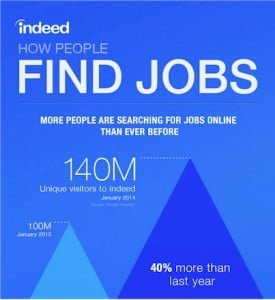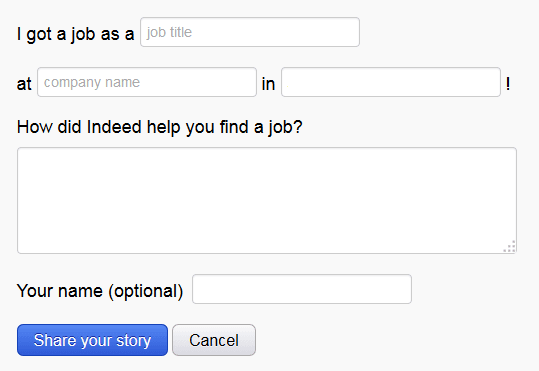In the April 2, 2014 Ask The Headhunter Newsletter, a reader asks me to stop dissing job boards:
You claim that job boards don’t work. Yet virtually every job in the world is advertised on job boards, and employers use job boards all the time! Just look at all the traffic they get. I think you’re missing the boat — please admit that there’s plenty of evidence the job boards do work!
Nick’s Reply
Here’s the problem with job boards today: None of them offer any evidence that they work.
What does it mean that “they work?” It means they actually match people with jobs. You know: find jobs for people and find people for jobs.
 About.com says, “The best sites for finding job listings in 2014 will help you find the most current job openings fast” (about.com). Finding job listings is one thing. But if job boards actually work, they should be able to show they are the cause of hires. They claim they are, but they offer no evidence.
About.com says, “The best sites for finding job listings in 2014 will help you find the most current job openings fast” (about.com). Finding job listings is one thing. But if job boards actually work, they should be able to show they are the cause of hires. They claim they are, but they offer no evidence.
Let’s look at Indeed.com, which is referred to as “arguably (and probably) the largest job search engine” (DigitalTrends).
On March 27, 2014, Indeed published an article and infographic titled “How 140 Million Unique Visitors Use Indeed to Find Jobs.”
On its face, the title seems clear — it’s going to tell you how people found jobs using Indeed. But the infographic shows nothing of the sort. In fact, contrary to the misleading title, the graphic seems to be very careful not to claim Indeed actually fills jobs. Let’s look at the data presented in that infographic (click here to follow along). It tells us everything except whether Indeed works:
1. 140 Million unique visitors each month. So what? What does tracking unique visitors have to do with actually filling jobs? All this tells us is that lots of people go there.
2. “Traffic on Indeed has increased by 40% over the past year.” Again, so what?
3. “Each month, 72% of online job seekers in the US visit Indeed.” But, how many get jobs there? There’s no mention of that. I’m still waiting for how all those people use Indeed to actually find jobs.
4. “There are 25 million resumes on Indeed that employers search for free.” Those employers could be printing resumes to line bird cages. Where are the stats on how many people they hired? All this statistic tells us is that employers might be stupid. Judging from the rising complaints about “a talent shortage” from employers, it seems “free” is worthless. And employers are indeed sometimes stupid.
5. “Job seekers use the 4 million employer reviews to research companies.” So what? They use Google to do the same. Does Google claim it fills jobs? Do we see a trend here? Lots of data showing big numbers, which seem impressive by themselves — but no outcomes analysis.
6. “45% of Indeed searches come from mobile.” Yah, so? Every marketing program today includes the obligatory reference to “mobile.” But how many of those searches yield hires?
7. There are 16 million jobs on Indeed worldwide, and 8.2 added per second. But how many are filled by people searching for jobs on Indeed?
8. Indeed is available in 50+ countries in 28 languages. Perhaps translators are getting jobs. What are the success rates by country?
The infographic slams us with impressive statistics about web traffic, numbers of job postings and resumes, percentages of job seekers that visit — all kinds of data. Indeed concludes that “More people find jobs on Indeed than anywhere else.” After scanning the clever infographic, you probably believe it.
Well, I don’t. I think it’s all b.s. All I see is that lots of people find job listings on Indeed. (Oops, could that be what Indeed really means?)
In the midst of all this promotional “info” there is not one shred of data that tells us how many people actually got jobs on Indeed, or how many jobs employers filled on Indeed. “People find jobs on Indeed” clearly means they found job listings in Indeed. So what?
The infographic is bogus. Those numbers do not indicate success rates. It’s classic deception by distraction that convinces people to keep patronizing job boards.
My challenge to job boards
I challenge Indeed.com, and every other job board: Show us your job fill rates and the success rates of job seekers who use the service, and point us to your data. Indeed’s revenues are not public, but they must be staggering. The company clearly spends a lot on advertising and promotion. You’d think that if Indeed had a shred of evidence that its service actually works, it would be prominently displayed in the infographic.
Why isn’t it?
I can’t find one word about Indeed’s success metrics on its website. Can you? Indeed features an “Engineering Blog” on its site — posts about database technology — but nothing about outcomes analysis or success metrics.
My guess is that Indeed’s dirty little secret is that human resources departments dump billions of dollars into an empty hole, and that nobody really cares how many jobs Indeed (or any job board) actually fills — as long as the cash keeps rolling in.
The job boards “show us the money” because they’re making it hand over fist. But they don’t show us results.
My challenge to employers:
I’ll make a second challenge to employers: Pay a job board only after you make a hire through that board. Suddenly, job boards will be able to accurately track who got hired from where. And you’ll know where your money is going. (This is no different from this challenge to job boards that charge job seekers.)
Funny thing
Every job board executive I’ve ever talked to claims that “there’s just no way we can track actual hires — it’s too complicated.” Gimme a break. Web analytics is rocket science today — we can track virtually everything you do online — and there’s no way to figure out whether a job board was the cause of a job being filled? Wouldn’t the very best job service be designed to ensure it gathers the necessary data to prove it works? I mean, what are all those “data scientists” for, anyway?
I think the truth is simpler: Indeed.com and most of the other job boards (the bigger, the worse) use deceptive marketing tactics to imply bogus benefits. Certainly, they fill some jobs, but just because millions of people gamble doesn’t mean enough of them win to justify the practice. All it means is that the house wins.
While you keep job hunting, you generate more visits to Indeed.com, which yields dramatic increases in “the data” — and in the number of suckers born every minute.
Do job boards work? I’d love to hear from employers who actually know where their hires came from. Did you get a job through Indeed? What’s your best source of hires — or jobs?
: :
 Wow! Look at all the millions of success stories people have posted! Now click the button at the upper right of that page, labeled “Add your story.” Indeed gives you a form:
Wow! Look at all the millions of success stories people have posted! Now click the button at the upper right of that page, labeled “Add your story.” Indeed gives you a form: awfully tired! Indeed is helping people get jobs… where? Why, in Anonymous Proxy! (Hey, is that in Ohio?)
awfully tired! Indeed is helping people get jobs… where? Why, in Anonymous Proxy! (Hey, is that in Ohio?)


